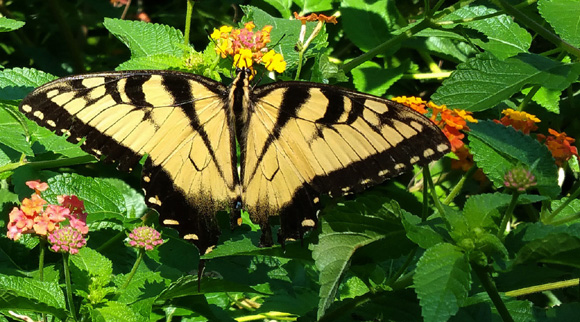I either inherited my love of gardening from my mother or absorbed it
through exposure nearly from birth. More likely, both.I spent my fist
nine years on a farm where my family raised a few kinds of animals and
grew our own vegetables. Despite all the work my mom had with three
active children, a husband who worked full time in the city, a
dilapidated old house, 80 acres of land, and a part time teaching job, she still
found time to grow flowers, just because they brought her so much joy!

Mom is looking through a family
photo album I made for her
when her memory started to fail.
She was diagnosed
with Alzheimer's Disease after
her death at age 84.
Roses were her favorite flower. After my parents divorced, Mom and I moved to
the edge of our small town and had a smaller yard. She continued to grow
roses and many other kinds of flowers.
I helped, of course, and learned a lot in the process, not only about
the selection and care of plants but also how much fun it is to watch
them grow and thrive. I have followed my family tradition of playin' in
the dirt and growing beautiful things in my own yards in four different
states since my early 20s.
And that, my friends, has been almost fifty years!
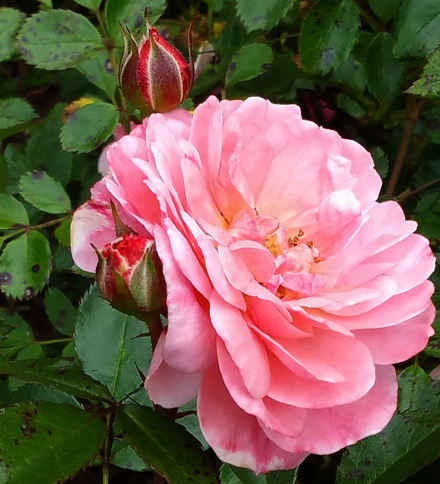
Mom would have loved this
multi-layered peach Drift rose! (4-29-20)
Roses weren't a favorite of mine to grow until fairly recently. Mom always
had the older types that needed lots of maintenance. They were
beautiful and smelled great but I was too busy working, running, and
traveling to be bothered with
those, even after retiring, so until the last few years I had flowering
plants that were easier to grow.
I'm soooo glad I discovered Drift and Knockout roses when Jim and I
moved into our current house in spring of 2017 and had a relatively
blank slate in the back yard to transform. I did some research
about what thrives in our climate just south of Atlanta and saw that
these shrubs are popular here.
No wonder! I've had more luck with them than some of the other
perennials, shrubs, and trees I've planted in this yard. They have far
exceeded my expectations in beauty, variety, length of bloom, and low
maintenance required.
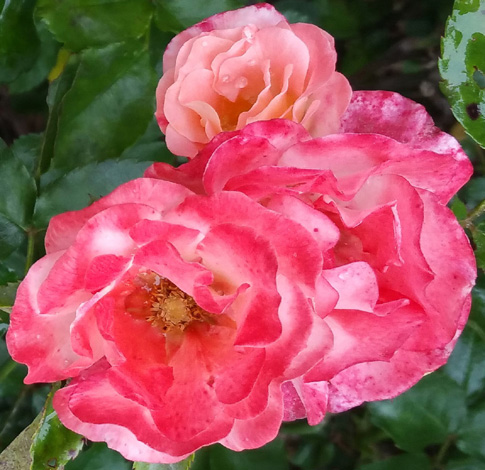
Above and next two below:
these are also peach Drift roses! There are many variations
on each shrub, which fascinates
me. These almost look like watercolors. (5-8-20)
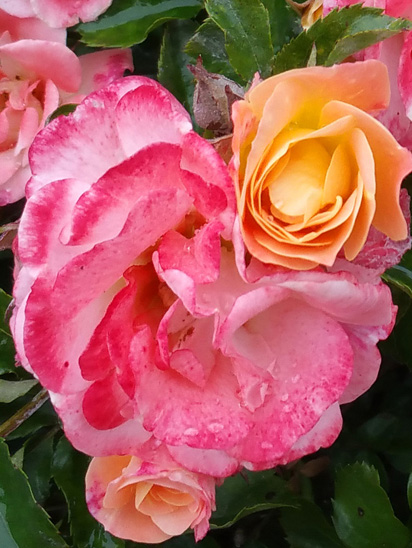
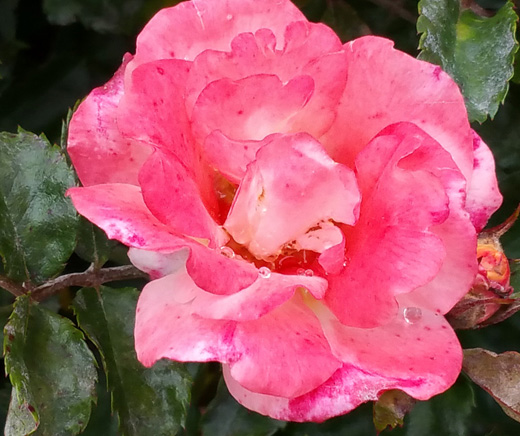
We currently have about sixty Drift and Knockout roses on our half
acre of land. Not only have all of them lived from two to four years,
they have flourished. They grew faster and bigger than
advertised, they flower continuously from early April until after several hard
frosts in December, the variety of flowers is amazing, and they require
minimal maintenance.
So when a recalcitrant Encore azalea dies, I'm likely to replace it
with a reliable Drift or Knockout rose!
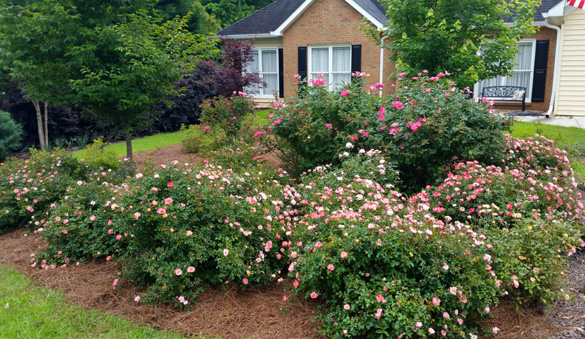
Above and below: gorgeous peach Drift roses brighten up the
front yard in late April; the close-up
shows another
variation. Taller, more solid pink Knockout roses are behind the Drifts.
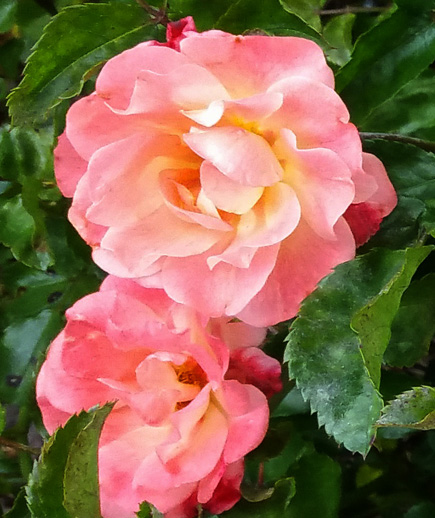
I don't know if any of our neighbors call me the Rose Lady, but if
they do, I'll take it as a compliment.
I do get compliments on the island of roses and azaleas we developed
in the front yard in May of 2018. Because of the tall wooden fencing
around the back yard, only a few friends and some surrounding neighbors
in two-story houses have a clue about all the roses and other things we
planted back there.
I'm writing this in early January, 2021 (despite the late August date
on this entry). We had several nights in the mid-20s F. in late December that
finally took out most of the roses. But not all of them -- they
are very hardy!
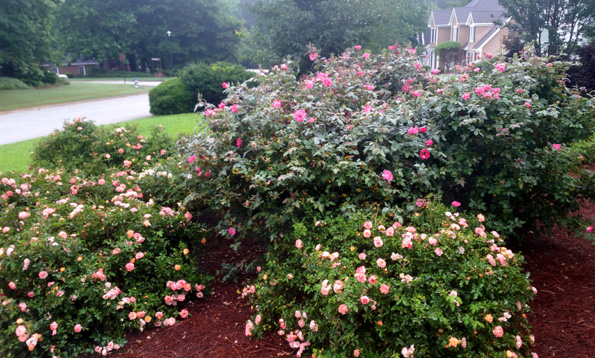
Drifts and Knockouts full of
blooms (6-9-20)
The next three photos show an unusual cluster of flowers on one of
the peach Drifts in June.
This variety has such a wide variety of shapes and colors, it's
amazing! The previous owners planted several peach Drifts on either side
of the front yard so I used them in the "island" area we dug up in the
middle of the yard.
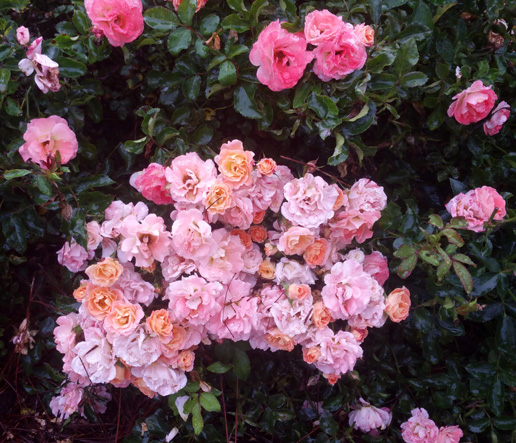
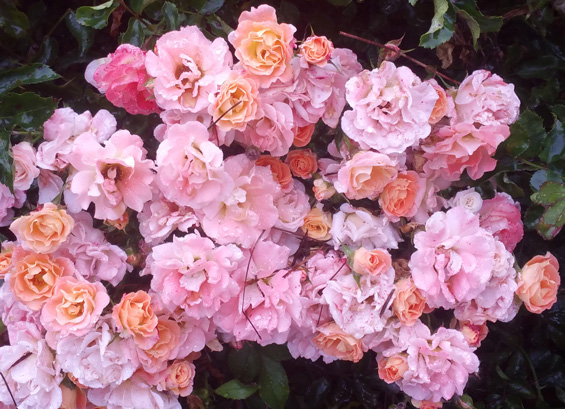
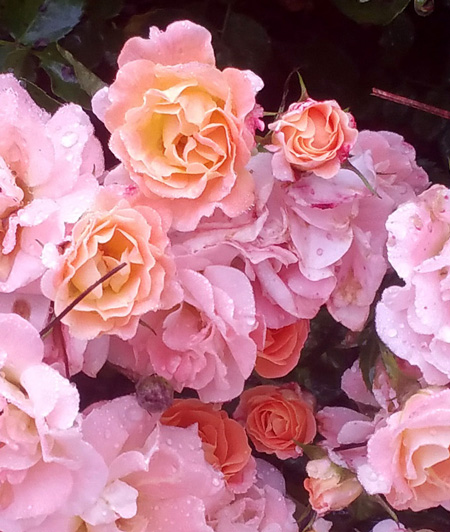
Aren't those gorgeous?
I've since added one pink Drift and one salmon Drift in the front
"island" but they're hard to distinguish from the peach ones since the
latter have so many different colors on each bush.
By mid-summer the two large crape myrtles on either side of our
front yard added additional color and interest:
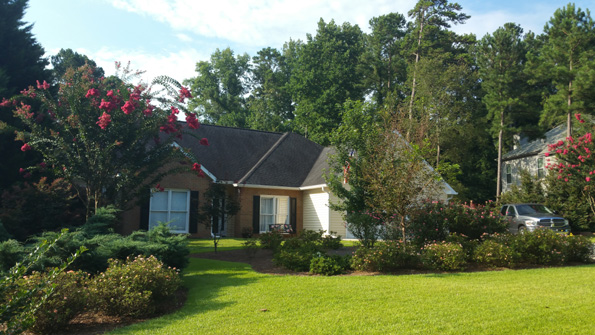
PHOTOS FROM THE "SECRET" GARDEN
I'm referring to our back yard, which fewer people have seen
because of the tall wooden fence surrounding it.
Beyond the patio is an arc of zoyzia grass surrounded by a large, wide
U-shaped mulched area where the previous owners took out 40+ large trees
shortly before we moved in. We have planted numerous shrubs, trees,
perennials, and groundcovers in an effort to make it look more appealing
and reduce erosion from mild slopes running front to back and side to side.
There is one large bed of about a dozen single and double pink Drift roses to the
left (east):
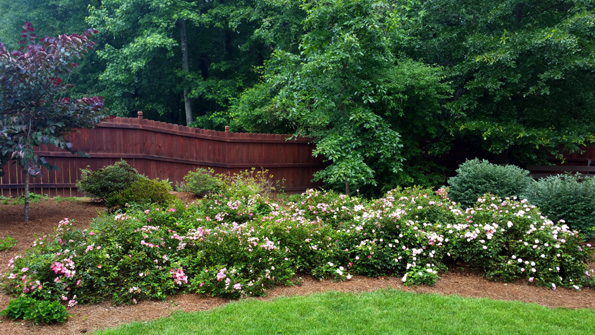
These bushes are covered in roses
from April to December (6-15-20)
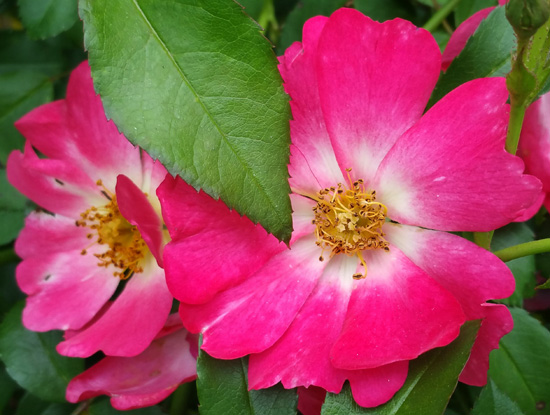
Single layer pink Drift (4-29-20)
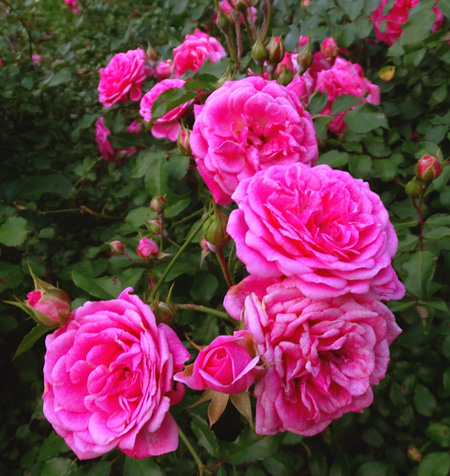
This is called Double Pink Drift
but the flowers have many more layers than that. (5-2-20)
There is another even longer bed of roses on the right (west) uphill
side of the yard.
I started with two pink Drifts, two red Drifts, and four Knockouts
in two colors the spring of 2017. This is what they looked like on April
24 of this year before the Drifts really got going (Drifts are considered
"groundcover" roses, although ours are two to three feet tall)
:
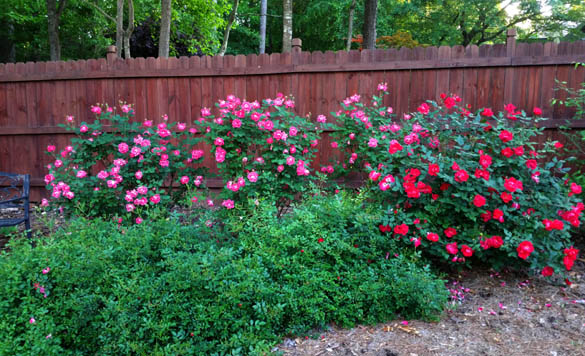
The Knockouts were already
covered in colorful flowers by mid-April.
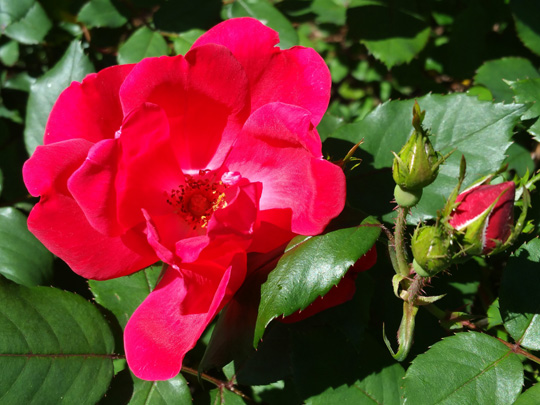
That will brighten up your spring!
(4-14-20)
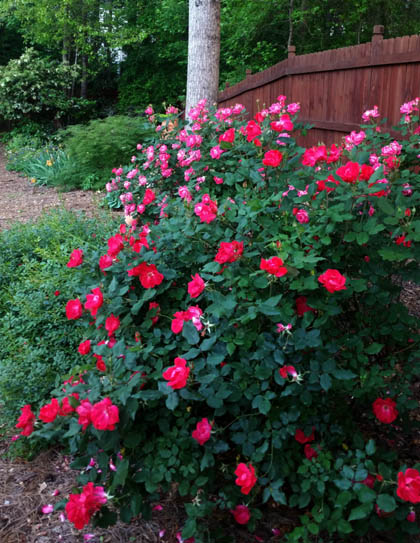
Same day, different angle
Within a couple weeks the pink and red Drift roses in
this bed were also in full bloom:
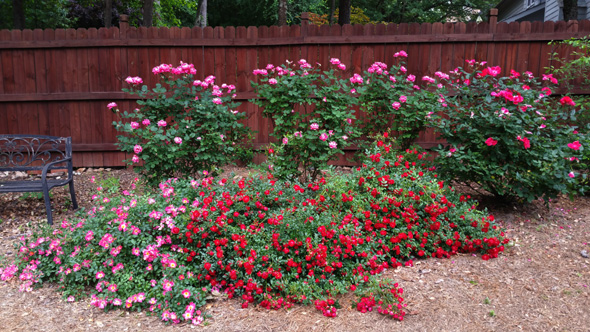
Roses galore! (5-8-20)
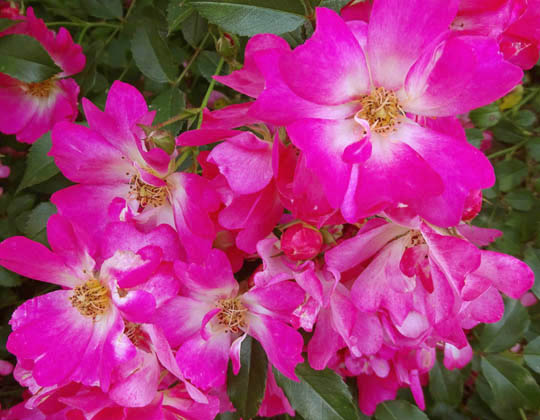
Single layer pink Drift (5-14-20)
The next spring (2018) I decided the bare strip of raised dirt along the west
side of the house needed some oomph, so I planted several pink Drift and pink
Knockout roses there, too. I added more in 2019 and 2020. Now there
are nine rose bushes in the raised bed plus the original eight near the bench.
Here's what part of that strip looked like in mid-April with the Knockouts blooming:
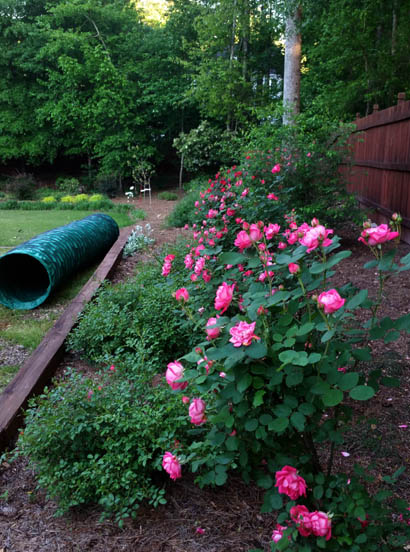
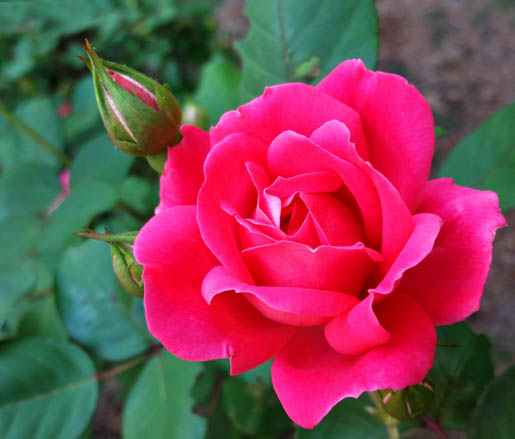
Drifts and Knockouts are relatively low maintenance. They do flower
more prolifically with fertilizer every month or two during the long
flowering season, water during a drought, and dead-heading of spent blossoms.
They are relatively free of pests in this area of Georgia, although in June we
had problems with Japanese beetles gorging mostly on the Knockouts -- both the
leaves and the flowers. I kept busy for about three weeks picking off
the buggers and putting them in containers of soapy water so they'd die. I
didn't want to use any chemicals that would harm any insects, wildlife, or the dogs.
Here are two pictures taken the same day, showing a damaged flower with
a beetle eating and unscathed flowers a couple feet away:
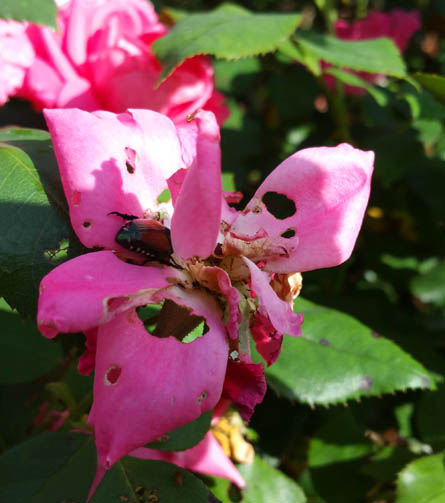
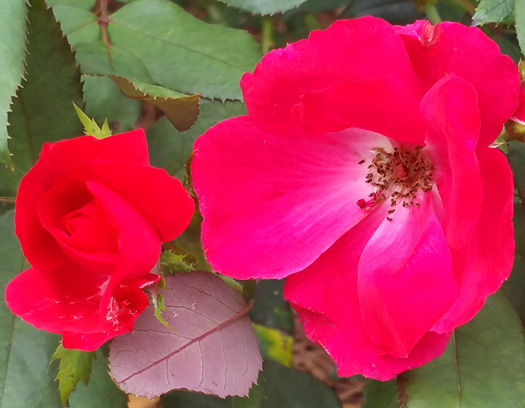
Although the roses mostly recovered and bloomed well again after the beetles
died or moved on to their next life state, we need to try to prevent their
return next another year. We had them once before but not last year.
Deer also like the Knockout leaves. They can't get to them in the
back yard but the roses in front are vulnerable. Rather than using
chemicals this year to deter the deer I put bunched-up chicken wire on
the ground around them. They don't like to step on something like that.
I mentioned how long Drifts and Knockouts bloom. Here's what one of the
beds looked like on November 24. We didn't have a hard frost until mid-December,
and there were still some buds that opened after several nights in the 20s F.
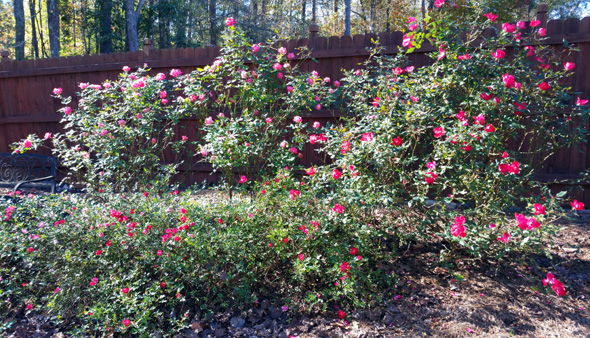
I'll probably post another entry in December with an update of
fall and winter nature scenes in our yard.
Next entry: Hey! How about we walk across Tennessee this summer?
Happy trails,
Sue
"Runtrails & Company" - Sue Norwood, Jim O'Neil,
Casey-Girl, Holly-Holly, & Dapper Don
Previous
Next
© 2020 Sue Norwood and Jim O'Neil
